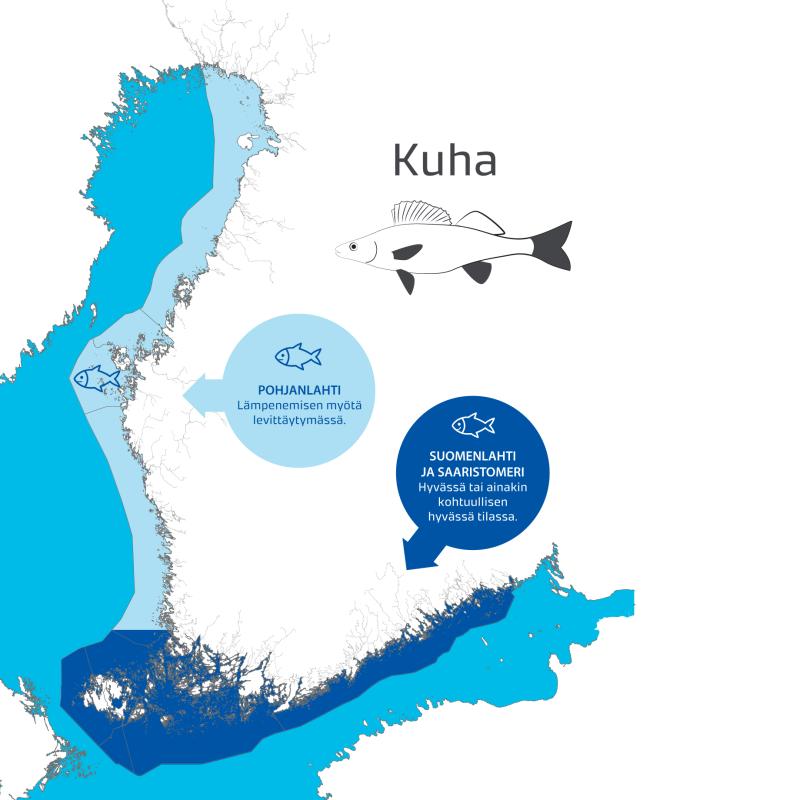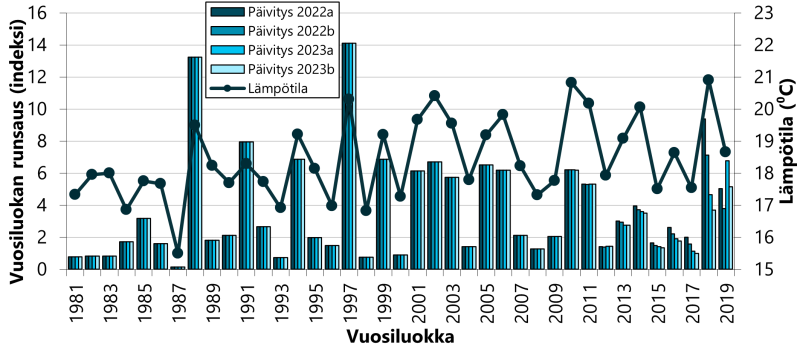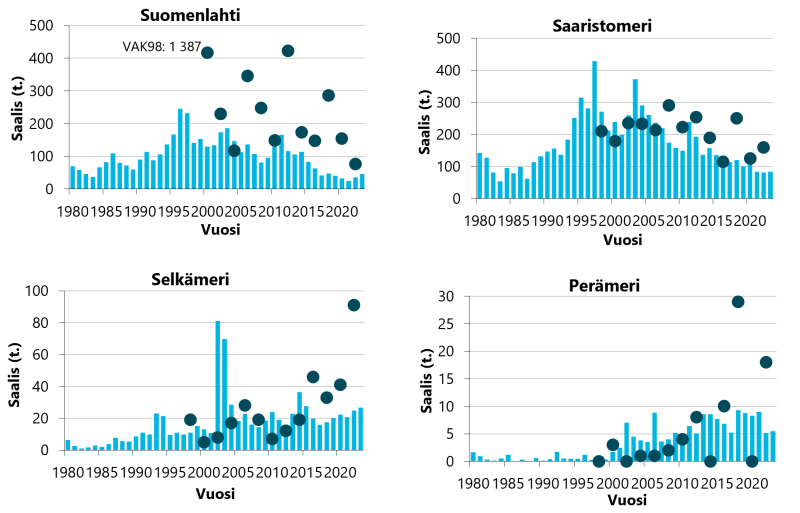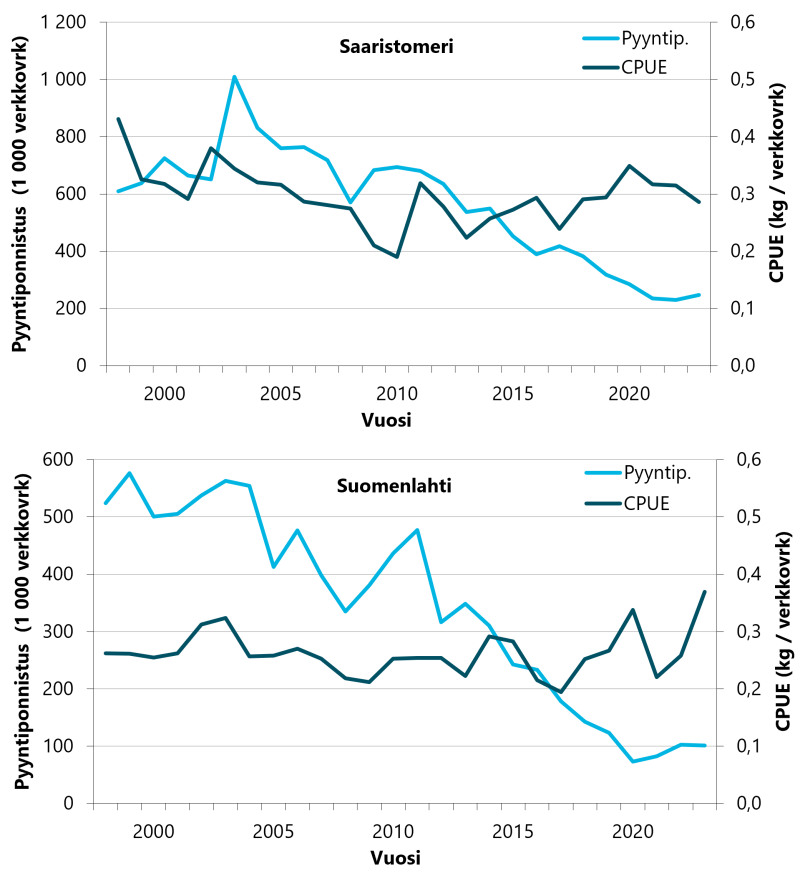
Pikeperch in the coastal area
On this page
The catch of pikeperch on the coast was still small, although it increased slightly. The lower catch in recent years is probably mainly due to reduced fishing effort. According to the latest population estimate, the year classes 2018–19 of pikeperch in the Archipelago Sea are quite strong, and the catch in 2024 will mainly depend on these. The number of individuals in the catch-sized population is declining, but biomass has increased. The average size of pikeperch is larger than before.
The decline in coastal pikeperch catches and fishing effort seem to have levelled off, so the catches are likely to remain more or less at the same level in the coming years. If the pikeperch biomass in the Archipelago Sea continues to grow, it is possible to catch more than before with the current fishing effort
The data reflects the state of the fish population in 2023, updated on 12.8.2024.

The year class strengths of pikeperch, and mean water temperatures in July-August
In the Archipelago Sea, the year-class 2018 of pikeperch is fairly strong based on the latest population estimate made by VPA (virtual population analysis), although it is smaller than last year's estimate. The year-class 2019 also looks quite strong at the moment, but the estimate is still very uncertain. The year-classes 2015–2017 do not seem very strong, and it is no longer possible to attain a large catch from the moderately strong year-classes 2013–2014. Therefore, the pikeperch catch in 2024 will mainly depend on the year-classes 2018-19. The year-class 2018 accounted for 35% of the pikeperch caught with gillnets in 2023 and the share of the year 2019 was already 25%, so the initial estimate of its strength may turn out to be correct

The abundance of pikeperch year-class in the Archipelago Sea depends mainly (about 80%) on the temperature in July–August and the limiting effect of the pikeperch stock size on recruits (Heikinheimo et al. 2014). The most abundant year-classes are usually born in a single warm summer from an average spawning population (e.g. 1988 and 1997).
The pikeperch stock size (>5-year-olds)
According to the VPA estimate , the number of individuals in the catch-sized pikeperch population in the Archipelago Sea is declining in 2016–2021. The main reason for this is probably that the year-classes formed in 2012 to 2017 were not as strong as in 2010 to 2011. In contrast, the estimate of spawning stock biomass has not declined as sharply and turned upwards in 2021. In 2022, the estimate of spawning stock biomass (1344 tn) was above the long-term average (1981-2020 mean = 1236 tn). The average size of pikeperch in the Archipelago Sea is larger than before and thus the total biomass is larger.

The catch of pikeperch in the commercial fishery in the Finnish coastal areas
In 2023, commercial catches of pikeperch on the coast (total 196 tonnes, preliminary data) increased slightly (19 tonnes) from the previous year, but were still among the lowest catches in the monitoring period starting in 1980.

The catch of pikeperch in the commercial, and the biennially estimated recreational pikeperch catch
The pikeperch catch increased from the previous year in the Gulf of Finland and the Bothnian Sea and remained almost at the previous year's level in the Archipelago Sea and the Bay of Bothnia. The Archipelago Sea remains the most important fishing area for pikeperch on the coast (catch share 43%). Over one-fifth of the pikeperch catch was caught in the Gulf of Finland and 14% in the Bothnian Sea. Åland and the southern sea area produced 18% of the catches and the Bay of Bothnia 3%.
In 2022, the estimate for recreational fishing in the sea area was 335 tonnes of pikeperch, which is more than 70% higher than the corresponding catch in commercial fishing. In the Gulf of Finland and the Archipelago Sea, the catch estimate has varied a lot, but has been lower in recent years. On the other hand, in more northern areas, the estimate of pikeperch catches in recreational fishing is increasing, probably due to the spread of pikeperch and the better survival of juveniles (Olin et al. 2023).

The estimate of regional catches of pikeperch in recreational fishing involves great uncertainty, which is reflected in the strong fluctuation of estimates, especially in the Bay of Bothnia.
CPUE is not a problem-free indicator of fish stock abundance (Olin & Raitaniemi 2022a), but changes in pikeperch stock and average weight support CPUE observations.
The gillnet fishing effort and CPUE of commercial pikeperch fishery
The gillnet fishing effort of commercial pikeperch fishing in the Archipelago Sea increased slightly from the previous year, but was still at a very low level (246,660 net days). In the Gulf of Finland, the fishing effort (100,679 net days) was about the same as in the previous year. In 2022, the gillnet CPUE in the Archipelago Sea (286 g/net day) was lower than in previous years, but still at a relatively high level. In the Archipelago Sea statistical grid 52, the CPUE has increased in recent years and was 674 g/net day in 2023. In the statistical grid 47, the CPUE (219 g/net day) decreased slightly. In the Gulf of Finland, CPUE (369 g/net day) increased sharply and was the highest during the study period. The recruitment of the strong year group 2018 increased CPUEs in the Gulf of Finland, but CPUEs in the Archipelago Sea, which is experiencing slower growth, will not increase until 2024.

VPA is based on an estimate of age-group-specific natural mortality, pikeperch catches from national commercial and recreational fishing statistics, age distributions and average weights estimated based on Luke's sample data. In VPA's stock assessment, the last few years are the most uncertain, and their results show the most variation between different updates. The results present updates based on data for 2022 and 2023 and two different values of terminal fishing mortality (i.e. fishing mortality in the last year). For more information on the VPA method used, see Olin & Raitaniemi 2022a.
Sources
Heikinheimo, O., Pekcan-Hekim, Z. & Raitaniemi, J. 2014. Spawning stock–recruitment relationship in pikeperch Sander lucioperca (L.) in the Baltic Sea, with temperature as an environmental effect. Fisheries Research 155: 1–9.
Olin, M & Raitaniemi, J. 2022a. Merialueen kuha. Julkaisussa: Kalakantojen tila vuonna 2021 sekä ennuste vuosille 2022 ja 2023: Silakka, kilohaili, turska, lohi, meritaimen, siika, kuha, ahven ja hauki. Luonnonvara- ja biotalouden tutkimus 72/2022: 89–107.
Olin, M., Heikinheimo, O., Lehtonen, T. & Raitaniemi, J. 2023. Long-term monitoring of pikeperch (Sander lucioperca) populations under increasing temperatures and predator abundances in the Finnish coastal waters of the Baltic Sea. Ecology of freshwater fish.
Experts


